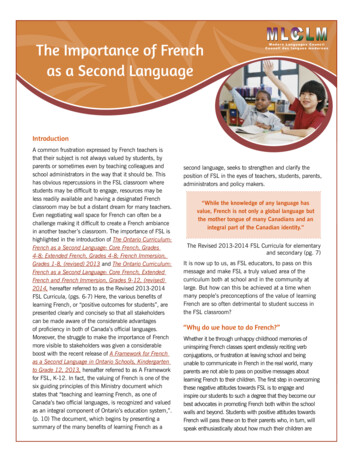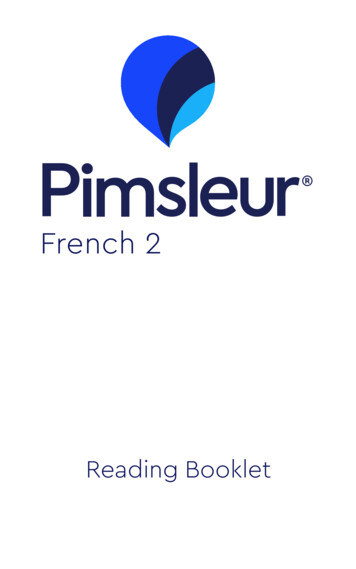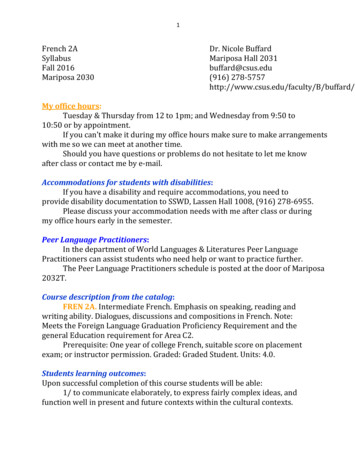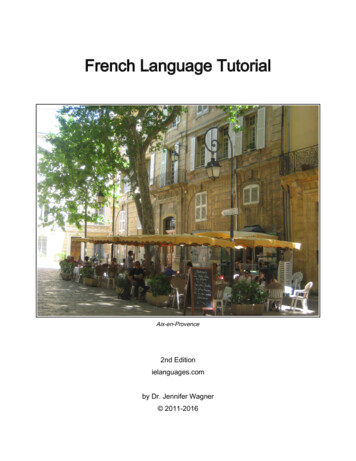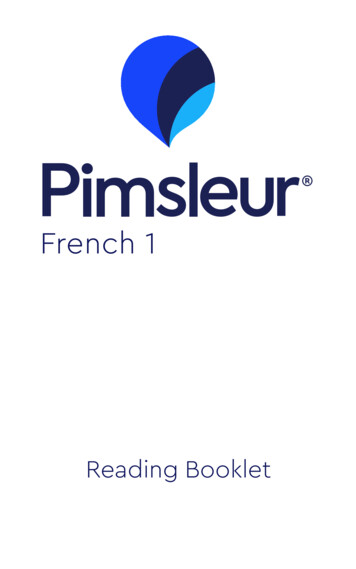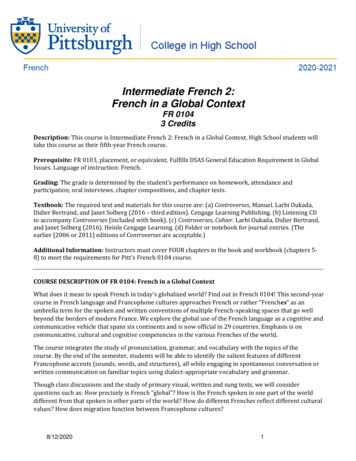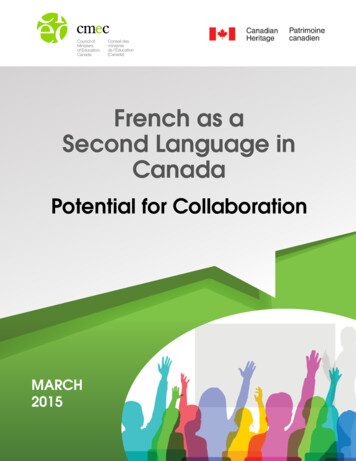
Transcription
French as aSecond Language inCanadaPotential for CollaborationMARCH2015
AcknowledgementsThe Council of Ministers of Education, Canada, would like to thank the following team of consultantsfrom the Canadian Association of Second Language Teachers (CASLT) for their work on the projectand preparation of this report: **Stephanie Arnott, Ph.D., University of OttawaDoug Hart, Ph.D., Ontario Institute for Studies in Education (retired)Sharon Lapkin, Ph.D., University of Toronto (Professor Emerita)Callie Mady, Ph.D., Nipissing UniversityLarry Vandergrift, Ph.D., University of Ottawa (Professor Emeritus)Marie-Emilie Masson, University of Toronto (graduate research assistant)We also thank the three focus-group facilitators as well as the focus-group and survey participantswho provided rich data for this study. We are grateful for the opportunity to take the pulse of FSLeducation across Canada.Council of Ministers of Education, Canada95 St. Clair Avenue West, Suite 1106Toronto, Ontario M4V 1N6Telephone: 416-962-8100Fax: 416-962-2800E-mail: cmec@cmec.ca 2015 Council of Ministers of Education, CanadaCe rapport est également disponible en français.** The views expressed in this report are those of the authors and do not necessarily reflect the opinions of the Council ofMinisters of Education, Canada.
Table of ContentsContext. 21. Literature review. 32. Methodology . 32.1 Research questions. 32.2 Data-collection phases. 33. Focus-group findings. 53.1 Strengths of FSL programs. 53.2 Challenges of FSL programs. 63.3 Collaboration among jurisdictions . 73.4 Research priorities. 74. Survey findings. 84.1 Priority areas for collaborative attention from P/Ts. 84.2 Receptiveness to learning from other jurisdictions. 95. Summary of main findings. 106. Implications. 10References. 11APPENDIX A. 12APPENDIX B. 20APPENDIX C. 23POTENTIAL FOR COLLABORATIONFRENCH AS A SECOND LANGUAGE IN CANADA1
ContextThe Council of Ministers of Education, Canada (CMEC), received funding from the Department ofCanadian Heritage, Official Languages Support Programs, for a project housed at the CanadianAssociation of Second Language Teachers (CASLT) that began during the summer of 2014. The projecthad two main goals: (1) to provide an overview of issues in FSL teaching and learning that are “top ofmind” across the various regions of Canada; and (2) to identify areas where collaboration among theprovinces and territories (P/Ts1) is occurring and would be productive in improving FSL education.The report is organized as follows: for reasons of length, the literature review developed for theproposal is included as APPENDIX A. The body of the report contains, first, a discussion of themethodology of the study (research questions and data collection phases); next, the findings from thefocus groups and the survey; and lastly, a summary of the main findings and the implications of thestudy.12“P/T” refers to provinces and territories or provincial and territorial.FRENCH AS A SECOND LANGUAGE IN CANADAPOTENTIAL FOR COLLABORATION
1. Literature reviewThe proposal for this project included a wide-ranging literature review taking into account allthe issues identified as relevant to the scope of the project. That literature review is included inAPPENDIX A; relevant literature is cited as needed in the interpretation of the findings of this study.2. Methodology2.1 Research questionsThe research questions guiding the study are:1. What are the strengths of FSL programs currently in place in P/Ts? Which do they have incommon?2. What are the main challenges in FSL programs in P/Ts? Which do they have in common?3. In what ways do P/Ts currently collaborate to improve FSL programs?4. What are the top research priorities for the coming decade related to FSL education inCanada based on the findings of this study?5. What pan-Canadian planning, program, and pedagogy initiatives can be recommendedbased on the findings of this study?Of these five questions, the research team was instructed to place special emphasis on thefifth.2.2 Data-collection phases2.2.1 Focus groups2Focus groups were held in three regions of Canada: one in Atlantic Canada (PrinceEdward Island), one in central Canada (Ontario), and one in Western Canada that includedManitoba, Saskatchewan, Alberta, and Northwest Territories. British Columbia/Yukoncould not be included in this phase of the project, as there was an ongoing teachers’ strikein British Columbia; however, that region did participate in the survey phase (describedbelow). Taken together, focus-group participants included representatives from each of thefollowing categories: parents [Canadian Parents for French (CPF)]; pan-Canadian languageassociations [l’Association canadienne des professeurs d’immersion (ACPI), CASLT; P/Tlanguage associations; superintendents; consultants; ministries/departments of education;and universities (e.g., French departments, faculties of education). Those invited to participatewere distinguished by their knowledge of the issues and their contacts across their region andnationally. The focus-group sessions were expected to yield information and issues that hadnot previously been captured in the studies related to French as a Second Language (FSL) inCanada, most of which have been survey-based.Taken together, the three focus groups included 19 individuals representing: 2a range of P/Ts (Alberta, Manitoba, Northwest Territories, Nova Scotia, Ontario, PrinceEdward Island, and Saskatchewan);pan-Canadian and provincial language-teachers’ associations [e.g., CASLT, ACPI,As suggested by Krueger and Casey (2009), focus groups were used in order to: (a) obtain a range of ideas relating to FSLeducation across Canada; (b) identify areas of consensus and difference among various FSL stakeholders; and (c) uncoverfactors that influenced the participants’ opinions related to FSL.POTENTIAL FOR COLLABORATIONFRENCH AS A SECOND LANGUAGE IN CANADA3
the Ontario Modern Language Teachers’ Association/l’Association ontarienne desprofesseurs de langues vivantes (OMLTA/AOPLV)];CPF;school-district administrators;ministries/departments of education; anduniversities, including faculties of education and summer language institutes.Most participants were also teachers with wide-ranging experience in core (or basic),intensive, or immersion French. Some had international experience, and some had taughtEnglish as a Second Language (ESL) or in mainstream classrooms. Every participant wasasked to share his or her relevant experience, and each used somewhat different terminologyto describe his or her involvement. Thus, some people referred to FSL teaching (withoutspecifying the type of program), while others indicated specific programs and grade levels.The following bullets summarize much of the experience represented in the focus-groupparticipants: Eight (8) participants reported teaching in core/basic French in either elementary orsecondary school or both.Eight (8) reported teaching immersion at elementary or secondary levels.Ten (10) reported experience as French consultants or coordinators.Four (4) reported experience in school administration.Four (4) reported experience in a ministry/department of education.Six (6) reported playing a role/having played a role in CASLT or ACPI.Two (2) reported experience in pre-service teacher education.Since no focus-group participant was interviewed in depth about his or her work or volunteerexperiences, the above is not an exhaustive list but serves to illustrate the depth and breadthof experience represented in the groups.The research team conducted a content analysis of each transcript to identify themes,commonalities, and examples of interjurisdictional collaboration. The latter, in particular,informed the development of the survey instrument (see APPENDIX B).2.2.2SurveyFocus-group participants were asked to identify and contact up to eight people who areknowledgeable about FSL education in their regions. These included school administrators,teachers, active parents, university professors, or others. When contacted, these people alsoreceived a project description. In an effort to maximize coverage of all P/Ts, presidents ofP/T CPF branches and language associations (provincial and national) were also contacted,provided with the project description, and asked to complete the questionnaire. Further,to ensure participation on the part of British Columbia/Yukon and other areas that mightotherwise have been under-represented, the project liaison person and a few others (e.g.,the vice-president of CPF British Columbia) also contacted potential key respondents in theirareas. Names of additional participants were suggested by the CMEC representatives, andthese participants, too, received an invitation.All those who accepted to take part in the survey (APPENDIX B) indicated their willingness todo so in writing (by e-mail). They were then thanked and told to expect the survey in midNovember, although in fact it was distributed in early December 2014, and the survey wasconducted in the first half of that month. Of the 101 invitees contacted, 68 responded.4FRENCH AS A SECOND LANGUAGE IN CANADAPOTENTIAL FOR COLLABORATION
3. Focus-group findings3.1 Strengths of FSL programsTable 1 presents the findings relating to perceived strengths of FSL programs in the regionsrepresented. The first five bolded rows represent themes mentioned in at least two of thefocus groups. With respect to the other themes, it is important to note that, even if a particularstrength was identified by only one of the focus groups, that strength may well be presentin other P/Ts. For example, inclusion was mentioned explicitly by only one group, but weare aware that all ministries/departments of education across Canada have addressed thisissue. Moreover, some topics raised in only one group also arose in the research literature; forexample, the last row in the table concerns larger blocks of instructional time for core/basicFrench, an innovation that has been shown to enhance learning and pedagogy (Mady, 2008;Marshall, 2011).Table 1: Strengths of FSL programs identified by focus groups(the bolded rows represent themes mentioned in at least two of the focus groups)*StrengthsExamples cited by participantsCultural enrichment availableSalons du livre; French for the Future; Explore program;career fairsIntroduction of the diplôme d’études en langue française(DELF)Motivating to students; positive washback into dailyclassroom activitiesIntroduction of Common European Framework of Referencefor Languages (CEFR) conceptsLess isolation of core French teachersProfessional-development consortiaIntensive French yielding impressive resultsEnrolment in intensive French programs increasing in somejurisdictionsProfessional development opportunitiesProfil de perfectionnement in some jurisdictions; self-assessmenttool for teachers; professional-development (PD) days; summerbursaries for teachers; summer institutes; French-immersionprogram-advisory groups in some jurisdictions; training in “languageacross the curriculum”Availability of early literacy support in FrenchSupport from ministries/departments of educationNew curricula and resources; resource centres for teachersAvailability of effective teacher-education programsFederal-P/T agreements in the area of educationPartnerships with France in some school districts; funds for teachersto attend conferencesIncreased enrolment in immersionEmphasis on inclusionGreater diversity in enrolment (specifically mentioned in reference toimmersion)Blocking time for core/basic FrenchHour-long blocks with teachers proficient in French, rather thanshorter daily periods*The unbolded issues have also been documented in earlier studies and are considered equally important.There is evidence of progress over the last decade: for example, participants reported thatthe introduction of CEFR has resulted in more widely available cultural enrichment now. Thisobservation contrasts with Lapkin, MacFarlane, & Vandergrift’s findings (2006) showing thatFSL teacher respondents to a survey were “overwhelmingly dissatisfied with the ways inwhich francophone culture is reflected in available teaching materials, with library resources,computer software, and opportunities for French language support in the community” (p. 36).Other clear indications of progress are the multiple references to DELF and CEFR, absentfrom earlier studies. These resources have been introduced relatively recently and constitute asubstantive contribution to our thinking about FSL pedagogy and assessment.POTENTIAL FOR COLLABORATIONFRENCH AS A SECOND LANGUAGE IN CANADA5
3.2 Challenges of FSL programsTable 2 presents the challenges facing FSL programs identified by one or more of the focusgroups. These challenges and others have been well documented in the literature (e.g.,Lapkin, MacFarlane, & Vandergrift, 2006; Lapkin, Mady, & Arnott, 2009); it appears that theyremain salient today. In some cases, an issue listed as a strength in Table 1 (e.g., inclusion) isalso seen as a challenge (e.g., embracing diversity in classrooms); the fact that each of thesearose in only one of the focus groups does not diminish an issue’s importance.Further, looking at both Tables 1 and 2, it is evident that some P/Ts may have foundsolutions to challenges that others have not yet tried. In other words, in some P/Ts, solutionsor approaches to addressing challenges have been found through experimentation,innovation, and collaboration. For example, one focus-group participant suggested that themarginalization of core French teachers can be alleviated by the professional-developmentopportunities cited as a strength of their FSL programming (see Table 1). A second focusgroup participant reported that the challenge of “slow development of proficiency in core/basic French” could be addressed by “blocked instructional periods for core/basic French”with an effective teacher.Table 2: Challenges facing FSL programs(the bolded rows represent issues that were raised by at least two of the focus groups)ChallengesExamples cited by participantsLack of appropriate resources (books at the appropriateinterest level are too complex linguistically)Published books are geared to francophone learnersTeachers need to have had training in language-teachingmethodology, and they need to be proficient in FrenchShortage of qualified teachersBecause education is provincial/territorial, it is difficult toassess the L2 learning situation in Canada; lack of toolsfor measuring proficiency, especially speakingTransferability of students from program to program within andacross P/Ts; common terminology needed across P/Ts; lack ofcommon standards across CanadaWorking conditions for core French teachers;marginalization of core FrenchHigh turnover of teachers; decline in time allocated to coreFrench; recognition of FSL as mainstream (as important asmath)Student retention in programsLack of planning/continuity; no P/T requirement for FSLLack of tools for L2 assessment, particularly speakingSpeaking tends not to be assessed in the early gradesAccommodating a broad range of learners within classesImmersion students may be combined with core/basic French studentsat secondary levelLimited selection of subjects taught through French immersion atsecondary levelTimetabling of core/basic FrenchSlow development of proficiency in core FrenchAgreement needed for best practices in teacher education forFSLAlignment of universities with expectations at secondary levelNeed to motivate studentsNeed to value speaking rather than just reading/writingBringing ministries/departments of education togetherAccess to programs6FRENCH AS A SECOND LANGUAGE IN CANADALotteries to gain admission to immersionPOTENTIAL FOR COLLABORATION
3.3 Collaboration among provinces and territoriesThe concept of collaboration varies somewhat among the stakeholders represented in thefocus groups. Examples of within-P/T collaboration, within-region collaboration, and panCanadian collaboration are listed below and include formal and informal communication,dissemination of information from other P/Ts related to FSL initiatives, established formalizedpartnerships, and borrowing ideas or materials from other P/Ts.National associations such as CASLT are valued for the networking opportunities theyprovide (the CASLT leadership folios were specifically mentioned as a resource). Similarly,ACPI was mentioned for its sessions on guidebooks for administrators held in in the Westernprovinces. National (e.g., ACPI, CPF, CASLT) and provincial (e.g., OMLTA) conferences werealso cited for providing valuable networking opportunities; however, the need to hold nationalconferences in different regions of Canada in order to render them accessible to everyonewas underscored. Some examples of networking or collaboration include:a. within P/Ts: PD days are used to meet with teachers from other schools.There is communication within Ontario with teachers in “co-terminus” boards (i.e.,teachers from the public and Catholic school districts in the same geographical area).Partnerships between anglophone and francophone school districts have beenestablished in Alberta.b. within region or across Canada: Prince Edward Island has consulted Newfoundland and Labrador’s Intensive French (IF)model to incorporate strategies from IF into its core French program.Prince Edward Island borrowed New Brunswick’s oral proficiency test.Atlantic provinces worked together to align L2 curricula with the CEFR levels in an effortto reach a common understanding of the CEFR proficiency levels.Atlantic provinces developed an on-line portfolio to help students set proficiency goals;some school districts in Alberta are borrowing from this portfolio.There is a national steering committee for IF.Some school districts in Alberta are studying Ontario’s efforts to support teacherimplementation of the action-oriented approach.3Some school districts in Alberta have consulted Prince Edward Island’s Programme deperfectionnement linguistique.CPF executive directors meet regularly to discuss common issues and possible solutions.3.4 Research prioritiesThe focus-group discussions yielded one clear priority for research: finding answers towhy students drop out of French in secondary school. As the section entitled “Attrition” inAPPENDIX A describes, the answer to this question has yet to be firmly established based onthe research to date. While this trend of attrition from FSL programs has been documentedacross French immersion and core/basic French programs alike, it is much more prevalent3“The ‘action-oriented approach’ focuses on learning functional language related to accomplishing real-life tasks. This approachviews students as ‘social agents’ who use ‘acts of speech’ to interact with others in order to complete tasks that involve a‘purposeful action’ . to achieve a given result in the context of a problem to be solved, an obligation to fulfil or an objective tobe achieved” (Council of Europe, 2001, p. 10). (Ontario Ministry of Education, 2013, p. 32).POTENTIAL FOR COLLABORATIONFRENCH AS A SECOND LANGUAGE IN CANADA7
at the secondary level with core/basic French students when the study of French becomesoptional,4 which is often at the beginning of secondary school (Canadian Parents for French,2015).Retrospective accounts from core/basic French students who opted out of secondaryFSL study reveal that factors contributing to secondary-student attrition centre either onthe students’ lack of perceived competence or lack of opportunities to use and developtheir French skills (e.g., Atlantic Provinces Education Foundation, 2004; Blais, 2003). In thecase of secondary dropouts from all FSL programs, more school-based influences wereidentified, including “lack of course variety, forced choices between FSL and other programs,perception of heavy workload, or a misguided belief that better grades will be had outside ofFSL” (CPF, 2015). Ongoing small-scale research on the topic of motivation and demotivationof secondary students in core/basic French programs (Arnott, in progress; McGregor, inprogress) may shed light on what contributes to students’ decision-making process related toFSL studies when it is no longer a compulsory subject.4. Survey findings4.1 Priority areas for collaborative attention from P/TsRespondents were asked first to rate the extent to which a selection of topics might benefitfrom collaborative attention. They were also invited to suggest areas not on the list that couldbenefit from such attention. They were then asked to rank first and second priorities from thelisted areas and offered the opportunity to explain their selections.As the tables in APPENDIX C show, both ratings (Table C1) and rankings (Table C2) revealpriorities in three areas: developing speaking proficiency; building learner confidence,especially in speaking; and action-oriented pedagogical approaches. Approximately 60per cent of respondents identified these as three areas that would benefit a great dealfrom collaborative attention. These three areas garnered over 60 per cent of first-prioritynominations and almost 55 per cent of first- and second-priority nominations combined.The responses to open-ended items on the survey helped us understand the priorities thatemerged. For example, in the case of “developing speaking proficiency,” one respondentsuggested “an interprovincial round table on how to better teach speaking proficiency in FSLstudents”; another advocated “learning tasks that promote using French orally every day.”With respect to “developing learner confidence, especially in speaking,” one surveyrespondent commented:“Learners must be confident in their language skill, regardless of theirproficiency, in order to risk using the language and allow themselves tolearn. If the classroom environment is not encouraging and free of stress,students may hesitate to take risks and practise, interfering with languagelearning.8“4In some P/Ts, the study of French is not compulsory at any level; in others, it is obligatory from Grades 4 through 9.FRENCH AS A SECOND LANGUAGE IN CANADAPOTENTIAL FOR COLLABORATION
Finally, another respondent elaborated on his or her choice of the action-oriented approach,writing:“Because the action-oriented approach is based on the CEFR, choosingthis focus would be a means to deepen our understanding of theCEFR and provide tools appropriate for our classrooms. The CEFR is afoundational document useful for both students and teachers in core orimmersion but we lack Canadian examples. Action-oriented tasks withina Canadian context would be of great benefit.“In order to explore the relationships among the priorities listed in the survey, correlationalanalyses were done. Results of these analyses showed that developing speaking proficiencyand building learner confidence in speaking are thematically related, and also stronglycorrelated (see Table C3).In contrast, ratings for an action-oriented approach are not strongly correlated withdeveloping speaking proficiency and building learner confidence in speaking. The fact thatthere is only a weak statistical relationship among these may relate to respondents’ thinkingabout an action-oriented approach more broadly, perhaps in relation to the developmentof all four skills (reading, writing, listening, and speaking). In fact, any significant correlationbetween an action-oriented approach and task-based learning suggests that relevant tasksmay focus on reading, writing, and listening and not primarily on speaking.4.2 Receptiveness to learning from other provinces and territoriesThe first set of questions dealt with the perceived potential for collaboration to benefitparticular areas of FSL education. This was followed by two sets of questions — one forFrench immersion, the other for core/basic French — on the receptiveness of those locallyinvolved in FSL education to learn from other jurisdictions.With respect to French immersion, for all topics listed in Table C4, at least 80 per cent ofrespondents indicated that they were very or somewhat interested in what was being donein French immersion in other P/Ts. There are, however, differences among topics listed in thetable. There is stronger interest in what other P/Ts are doing at the elementary level than atthe secondary level. Over 60 per cent of respondents indicated that they were very interestedin the resources and pedagogy for Grades K–8 used in other P/Ts. There was only slightly lessinterest in supports for students with special-education needs, more relevant to elementarythan to secondary education.In the case of core/basic French, interest in what other P/Ts are doing was somewhat lesswidespread. However, for all topics listed in Table C5, at least 60 per cent of respondentsindicated that they were very or somewhat interested in what was being done in other P/Ts. Incontrast to French immersion, levels of interest in elementary and secondary resources andpedagogy are similar. There is much less interest in sharing on the topic of special educationin core/basic French than there is on sharing on special education in immersion. Similarly,learning about what other P/Ts are doing in regard to student retention garners more interestwith respect to immersion than it does for core/basic French.POTENTIAL FOR COLLABORATIONFRENCH AS A SECOND LANGUAGE IN CANADA9
5. Summary of main findingsThe focus groups addressed both the strengths and the challenges of FSL programs acrossCanada. It is evident that since earlier relevant surveys (Lapkin, MacFarlane, & Vandergrift, 2006),progress has been made in terms of the availability of cultural enrichment, more professionaldevelopment opportunities, and a greater emphasis on inclusion, among others. The newest andmost prevalent strength is the introduction of the CEFR, with its pedagogical innovations andrelated assessment strategies.The importance of CEFR was underlined in both the focus-group and survey data and is echoed inthe representative open-ended comments included in section 4 of this report. These findings showthat Canadian stakeholders see CEFR as a strength of FSL programs, with potential to informassessment and pedagogy. Participants also reported that working with CEFR could address othercentral issues that were raised repeatedly: developing speaking proficiency, providing relevantprofessional development to teachers, providing a direction for resource development, and so on.The challenges identified in the focus-group discussions were wide-ranging and echoed thoseidentified in earlier surveys and literature reviews (e.g., Lapkin, MacFarlane, & Vandergrift, 2006;Lapkin, Mady, & Arnott, 2009). Salient among these were recurrent themes in the discussions:inadequate supply of qualified teachers (language-proficient and skilled in L2 pedagogy) and theneed for common benchmarks and resource development, especially for the upper-secondarygrades. There was also a call for research to address student attrition at the secondary level, withinterest in collaborating on the subject of retention of French immersion students in particular.Relevant pedagogical and empirical initiatives examining how to increase student motivation andretention at all levels of FSL would be productive directions in response to these findings (forongoing work in this regard, see Arnott, in progress; McGregor, in progress).A prominent theme in the focus-group discussions, and one that carried over into the surveyresults and open-ended responses was the need for mutually understood proficiency benchmarks;CEFR was most often mentioned in this regard. Such benchmarks might serve to address studentretention and diversity created by movement of students among programs, both locally andbetween provinces and territories.Interjurisdictional collaboration is occurring, both within and across P/Ts. National associations are
POTENTIAL FOR COLLABORATION FRENCH AS A SECOND LANGUAGE IN CANADA 5 Table 1: Strengths of FSL programs identified by focus groups (the bolded rows represent themes mentioned in at least two of the focus groups)* Strengths Examples cited by participants Cultural enrichment available Salons du livre; French for the Future; Explore program; career .
